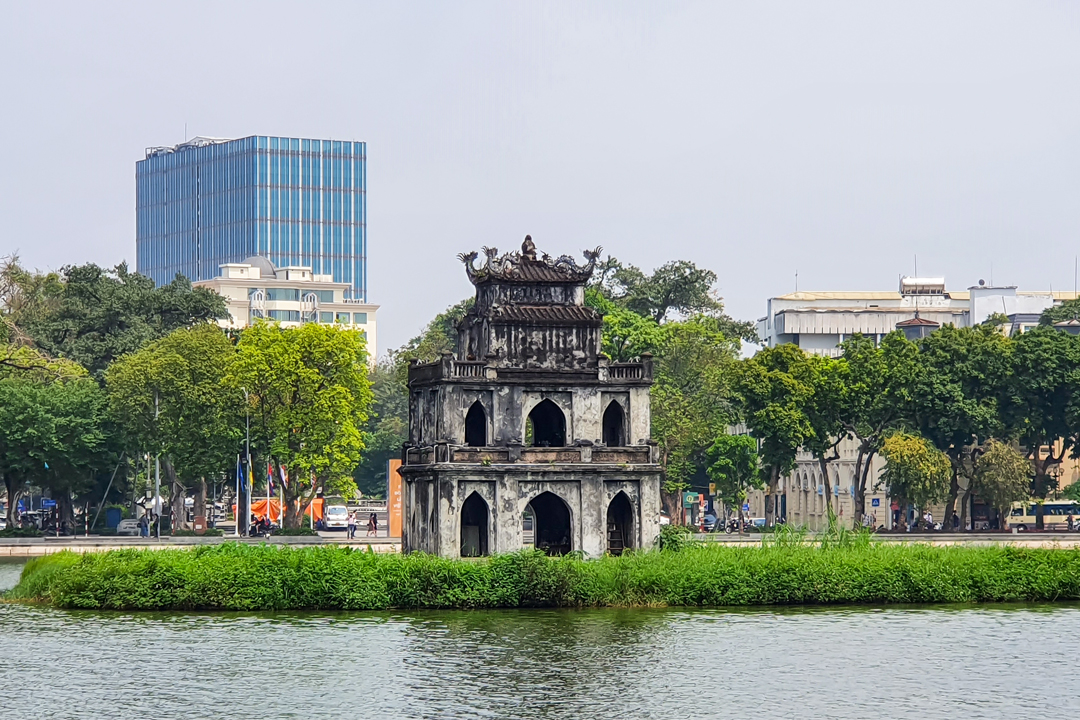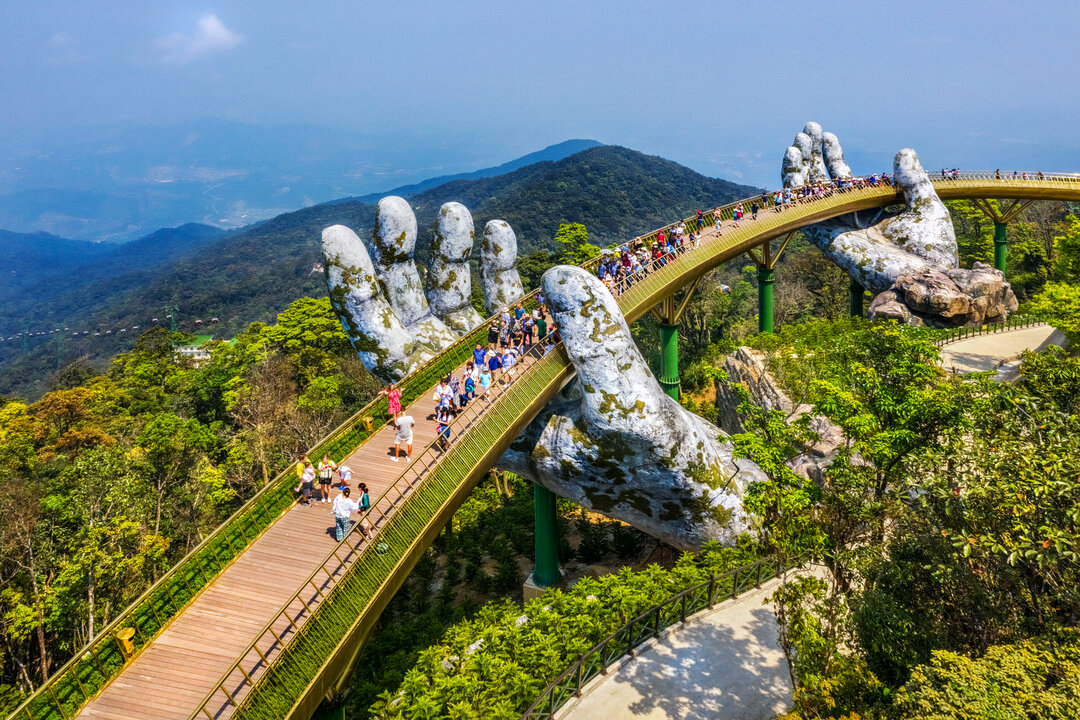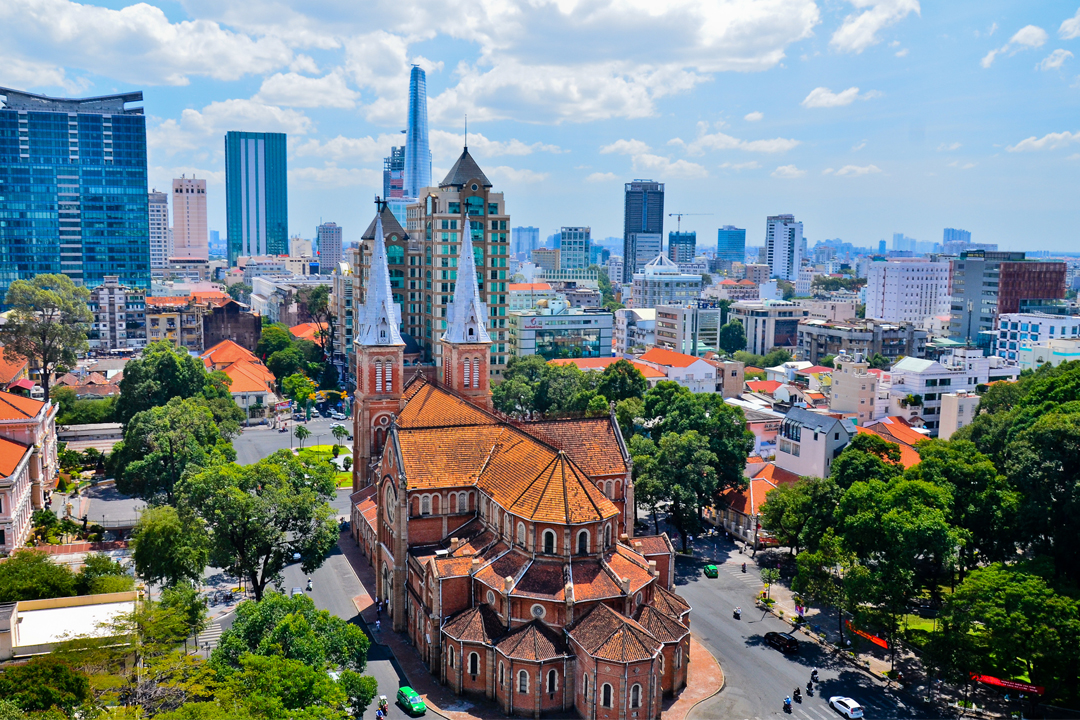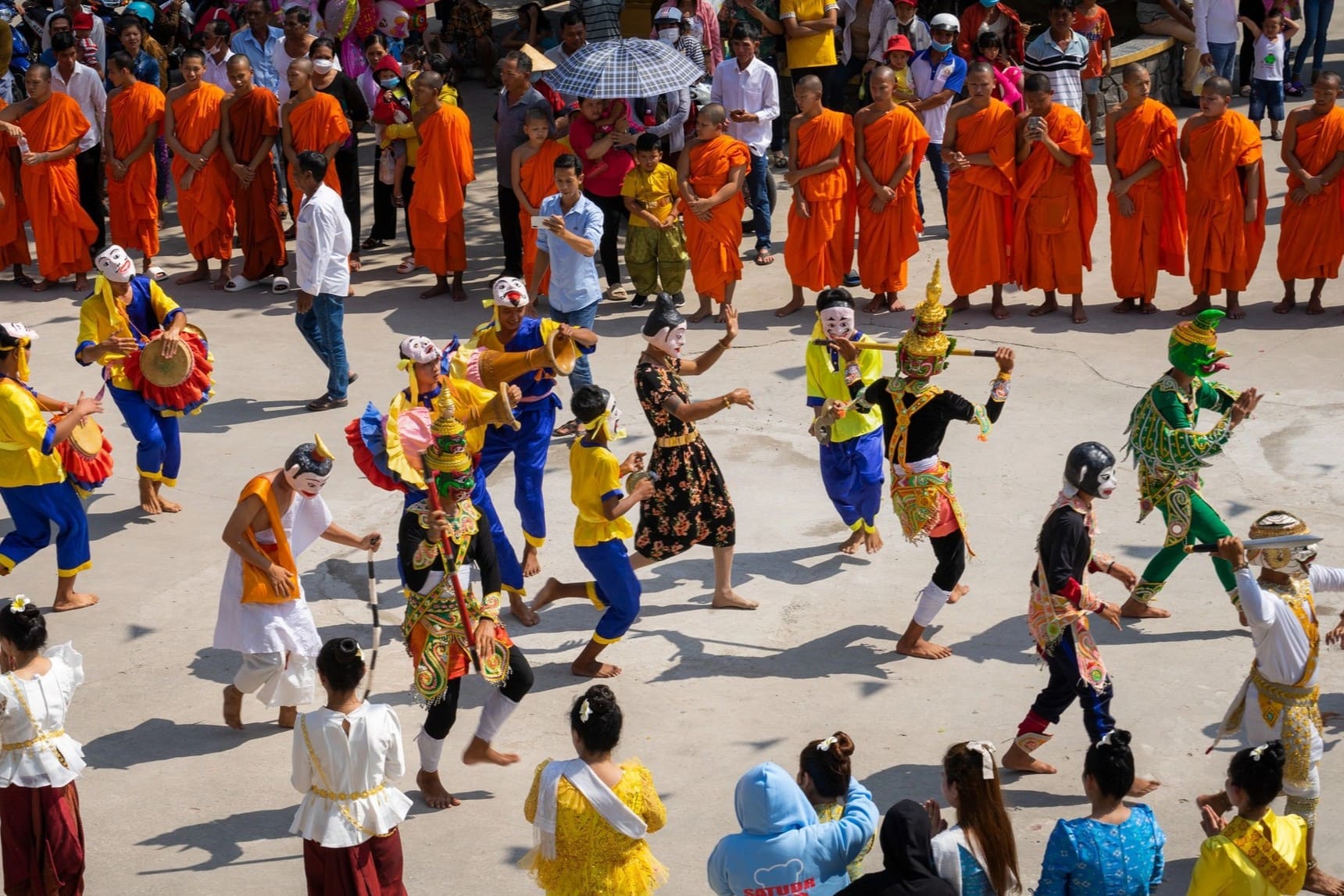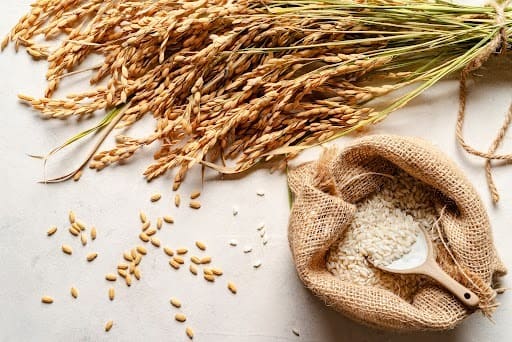Dalat Cathedral - The Cock Church: History, Things To Do & Tips When Visit
Dalat Cathedral stands as one of the most iconic religious landmarks in Dalat. Built during the French colonial period, this architectural masterpiece reflects European influences from its towering bell tower to the mesmerizing stained glass windows. Beyond its historical and religious significance, Dalat Cathedral remains a must-visit attraction for those seeking to explore the city's rich cultural heritage.
Located at No. 15, Tran Phu Street, Ward 3, Dalat City, Lam Dong Province, the cathedral offers regular religious services for both locals and travelers. The mass schedule includes Sunday: 5:30 AM, 7:00 AM, 8:30 AM, 4:00 PM, 6:00 PM, and other days: 5:15 AM & 5:15 PM.
This guide of GTrip delves into every aspect of Dalat Cathedral, answering essential questions travelers often ask. Curious about its history and architectural style? Wondering about the best time to visit Dalat Cathedral or how to get there? Looking for recommendations on things to do nearby, including hidden photography spots and other famous attractions in Dalat? We cover it all.
You can also find practical information, including the mass schedule, religious services, and important tips to enhance your experience. For those planning a full itinerary, combine a visit to Dalat Cathedral with a scenic stop at Xuan Huong Lake or an adventure at Datanla Waterfall. Meanwhile, history buffs might appreciate a trip to the Old Train Station, a remarkable remnant of Dalat’s colonial past. For those looking to immerse themselves in unique architecture, the eccentric Crazy House provides a striking contrast to the classical elegance of the Cathedral.
History and significance of Dalat Cathedral
Dalat Cathedral, also known as The Cock Church, is one of the most historically significant religious sites in Dalat. Built in 1920 to replace a 1917 church, Dalat Cathedral was reconstructed in 1922 and rebuilt by the French in 1931-1932, completed in 1942. Designed in Romanesque style, it features arched windows, stained glass, and a rooster-topped bell tower, showcasing Dalat’s colonial-era grandeur.
The role of Dalat Cathedral in Vietnam’s colonial era
During the early 20th century, Dalat was developed as a retreat for French officials and wealthy Vietnamese due to its cool climate and picturesque landscapes. As the city grew, so did the need for religious institutions that catered to the Catholic population. The construction of Dalat Cathedral history was not only a response to this demand but also a statement of French architectural grandeur. The church was strategically positioned on a hill, offering a panoramic view of Xuan Huong Lake and the surrounding colonial-era villas. This location emphasized its importance as both a spiritual and social landmark.
Religious and cultural significance
Beyond its architectural beauty, Dalat Cathedral plays a crucial role in the religious life of the local community. The church continues to hold regular masses, attracting both residents and tourists who seek spiritual connection. Many Catholic families in Dalat have deep-rooted ties to the cathedral, with generations attending services and religious ceremonies here. The grand annual Christmas celebration at the cathedral is a major event, drawing large crowds who come to witness the spectacular decorations and participate in the gatherings.
Dalat Cathedral in modern times
Despite the passing of decades, Con Ga Church (“The Cock” meaning “Con Ga” in Vietnamese) history remains well-preserved, reflecting its enduring significance. The cathedral is not just a place of worship but also a prominent tourist attraction that captivates history enthusiasts, architecture lovers, and photographers. Tourists often combine their trip to the cathedral with a stop at the Old Train Station, another relic from the colonial era that showcases French engineering excellence in Dalat.
While its historical value is undeniable, Dalat Cathedral also serves as a reminder of the complex past shared between Vietnam and France. The fusion of local culture with European influence is evident in its structure and also in the customs and traditions that have developed around it over the years. Today, it remains a must-visit site for anyone looking to understand the historical depth of Dalat beyond its natural beauty.
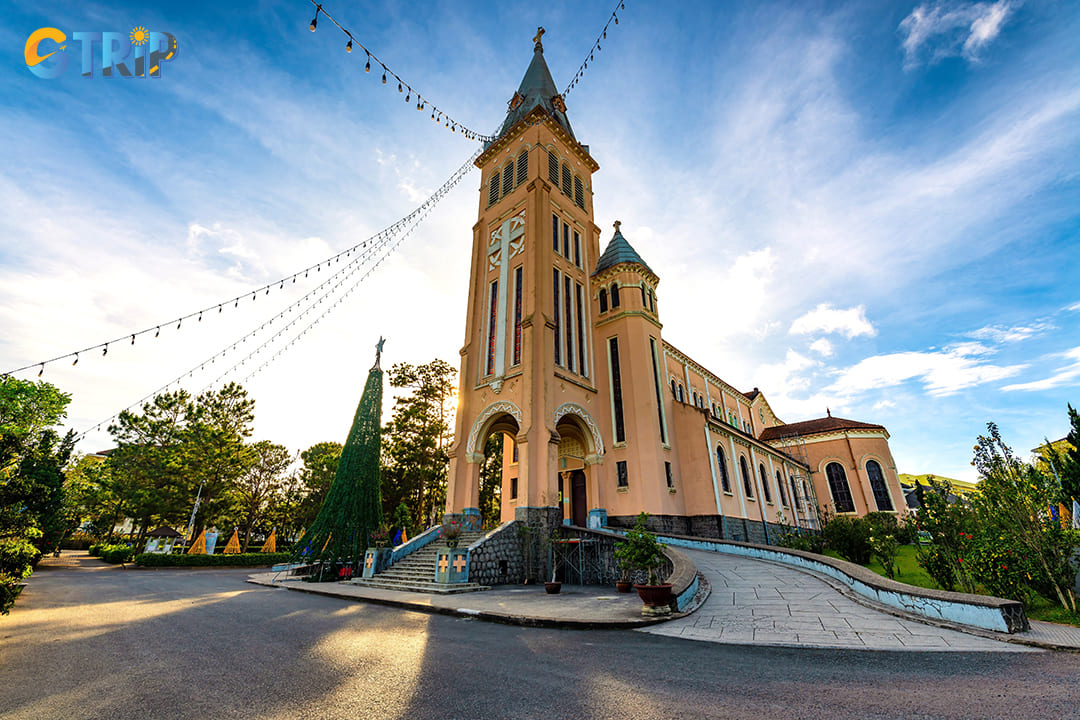
The Cock Church’s history remains well-preserved, reflecting its enduring significance
Moving beyond its historical and religious significance, the architectural elegance of Dalat Cathedral is another key aspect that makes it stand out. The church’s intricate details, high vaulted ceilings, and mesmerizing stained glass windows showcase the exquisite craftsmanship that defines French colonial architecture in Dalat.
Dalat Cathedral’s architectural style and interior design
Dalat Cathedral architecture style reflects the elegance of French colonial architecture in Dalat, making it one of the most striking religious landmarks in the city. Designed in a French Gothic style, the cathedral features a towering facade, pointed arches, and an elongated nave reminiscent of medieval European churches. The most distinctive feature of its exterior is the large bell tower, capped with a sharply pointed spire, which enhances the church’s grandeur while serving as a beacon visible from various points in Dalat.
Shaped like a cross, Dalat Cathedral spans 65 meters in length and 14 meters in width, following the traditional layout of European churches. Its grand proportions create a sense of solemnity and elegance, making it one of the most imposing religious structures in Dalat. The cathedral’s bell tower rises 47 meters high, dominating the skyline and serving as a guiding landmark visible from various parts of the city. For those standing at its base, the tower’s verticality emphasizes the grandeur of the structure, drawing the eye upward toward its sharply pointed spire.
Beyond its architectural prominence, the cathedral’s orientation holds symbolic and aesthetic significance. Its main entrance directly faces Langbiang Mountain, one of Dalat’s most famous natural landmarks. This alignment creates a harmonious connection between architecture and nature, allowing worshippers and tourists to appreciate the serene beauty of Dalat’s highland landscape. On clear days, the view from the cathedral’s surroundings offers a breathtaking perspective of rolling green hills and misty mountain peaks, reinforcing a sense of spiritual tranquility.
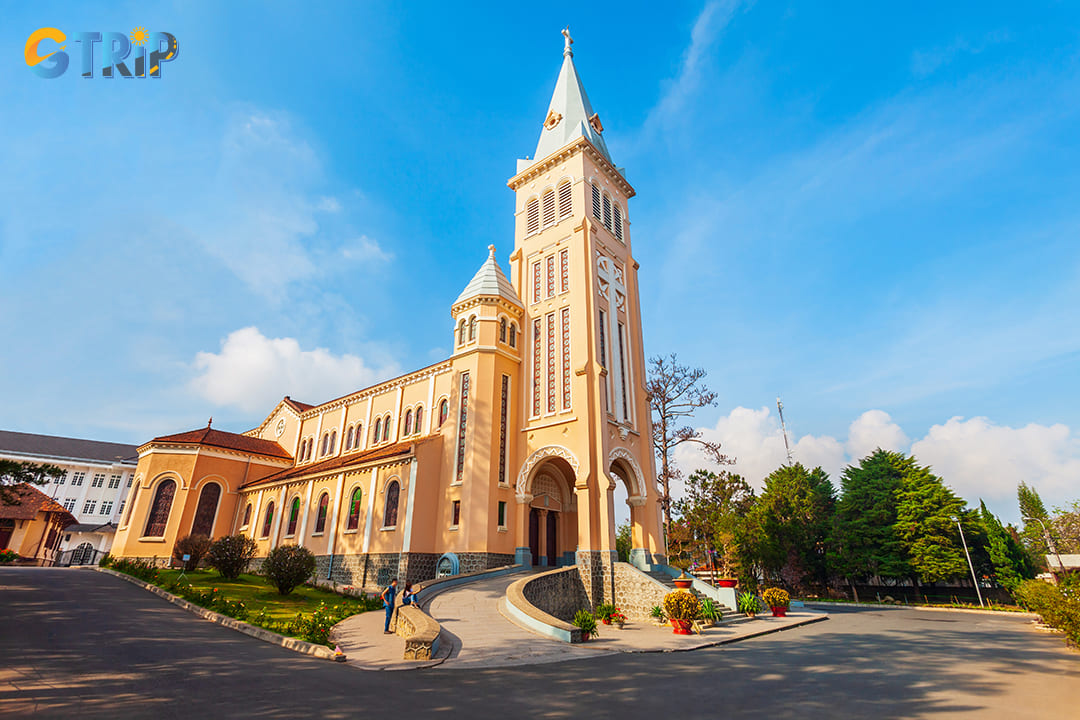
Dalat Cathedral architecture style reflects the elegance of French colonial architecture in Dalat
The cathedral's interior is a masterpiece of colonial-era design, blending grandeur with spiritual tranquility. Inside, Dalat Cathedral is divided into three main compartments. Upon entering, you are greeted by high vaulted ceilings, supported by sturdy columns that enhance the sense of openness and reverence. The central nave, the largest section, features rows of wooden pews leading to the main altar, the focal point for religious ceremonies. Flanking the nave are two side aisles, providing access to smaller chapels and religious artifacts, further enriching the church’s spiritual significance.
One of the most striking elements is the stained-glass windows, imported from France during the colonial period. These intricate glass panels depict biblical scenes and Christian symbols, casting vibrant hues across the prayer hall as sunlight filters through. The mesmerizing interplay of light and color creates a mystical ambiance, making the cathedral’s interior feel both sacred and visually enchanting. These stained-glass artworks remain among the most photographed features of Dalat Cathedral, a testament to their artistic and historical value.
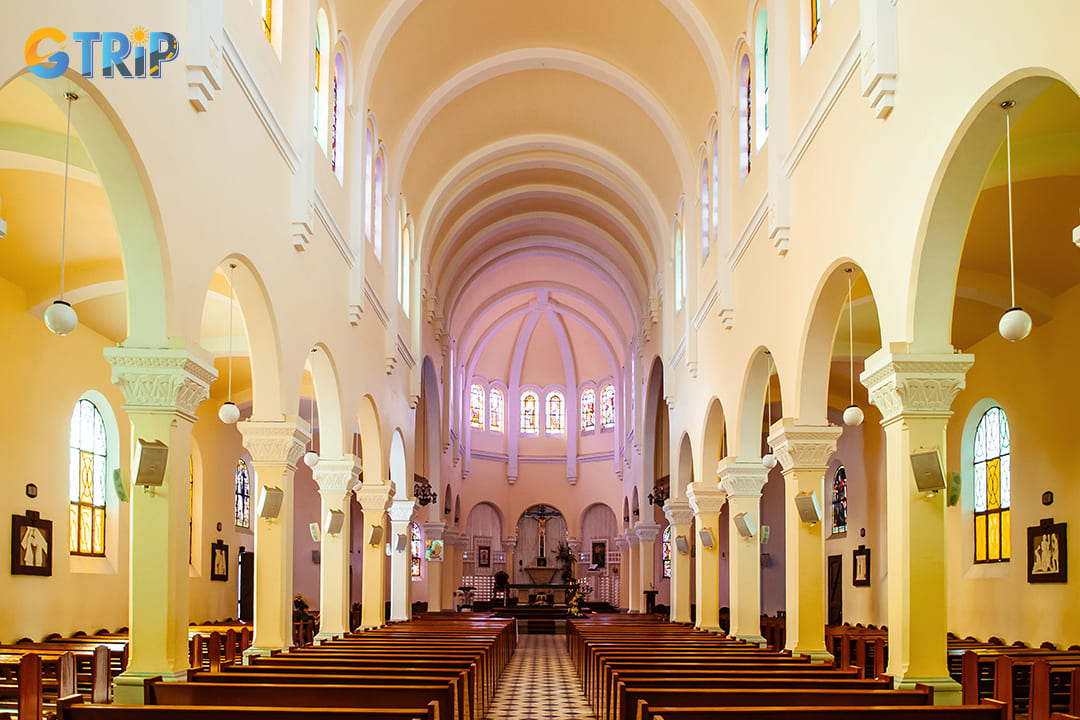
Upon stepping inside, you are greeted by high vaulted ceilings, supported by sturdy pillars that create a sense of openness and reverence
The cathedral is popularly known as The Cock Church due to the black bronze rooster statue perched atop its bell tower. This rooster, a symbol of France and its Christian heritage, represents the Gallic rooster, an emblem of vigilance and faith. Positioned on the cross at the peak of the tower, the rooster stands as a distinct feature of the cathedral’s silhouette. From a distance of about 100 meters, the statue is clearly visible, reinforcing the church’s identity as a significant French colonial landmark in Dalat.
Beyond its aesthetic charm, The Cock Church serves as a historical testament to the harmonious blend of Vietnamese culture and European architectural principles. This fusion is also evident in other colonial structures across Dalat, such as the Summer Palace of Bao Dai, where Western design elements intertwine with traditional Vietnamese motifs.
For travelers exploring Dalat, the cathedral’s architecture offers a glimpse into the city’s colonial past. After admiring its intricate details, you can continue your journey to nearby sites like Truc Lam Temple. This temple is where traditional Vietnamese pagoda architecture contrasts beautifully with the Western influence seen at Dalat Cathedral.
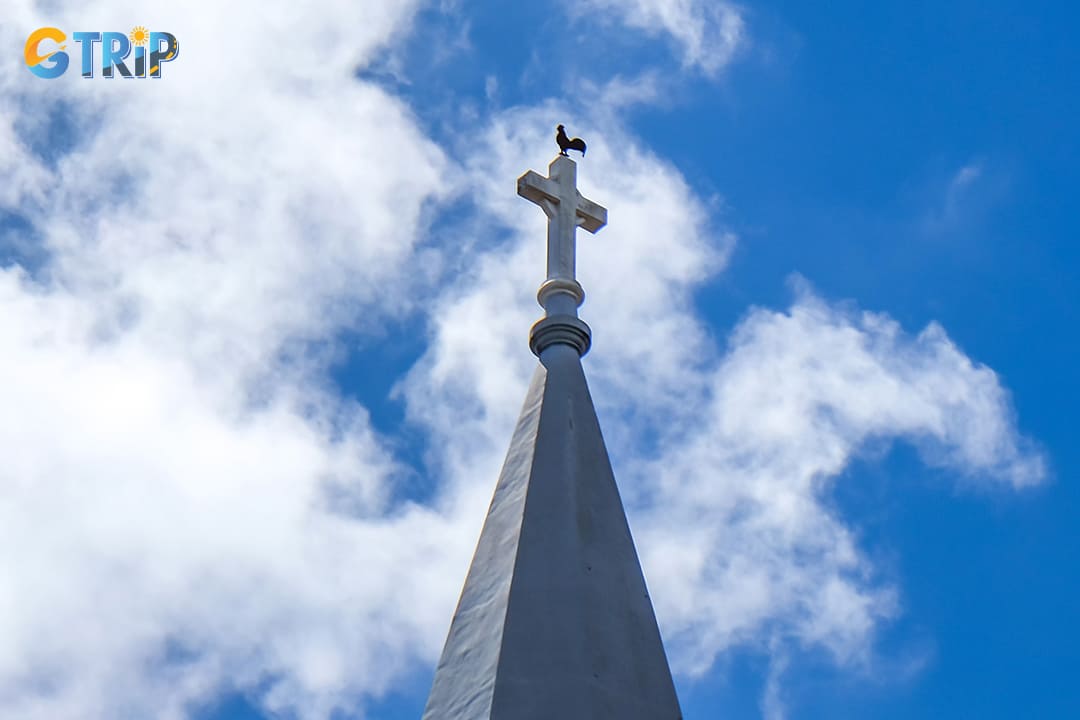
The cathedral is popularly known as The Cock Church due to the black bronze rooster statue perched atop its bell tower
When is the best time to visit Dalat Cathedral?
The best time to visit Dalat Cathedral is from November to April, which coincides with Dalat's dry season. Unlike the rainy season, which lasts from May to October, the dry season ensures clear skies and comfortable temperatures, typically ranging from 14°C to 24°C.
Why is November to April the ideal travel season?
- Pleasant weather: The cool climate during these months allows tourists to comfortably explore both the interior and exterior of the cathedral without worrying about sudden downpours or slippery walkways.
- Best for photography: With plenty of sunlight and minimal rainfall, this period provides excellent natural lighting for photographing Dalat Cathedral’s architecture and intricate stained glass windows.
- Festive atmosphere: If you visit in December, you can experience the Christmas celebrations at the cathedral, which attract both locals and tourists. The festive decorations and midnight masses create a spiritual and cultural highlight for everyone.
- Perfect for sightseeing: Since Dalat's peak tourist season falls between December and February, travelers can also explore other nearby attractions. You can visit the serene Tuyen Lam Lake or the beautifully landscaped Dalat Flower Garden.
Tips for visiting Dalat Cathedral during the dry season
- Visit in the morning for the best lighting conditions and fewer crowds. The sunlight shining through the cathedral’s stained glass windows creates a breathtaking effect inside.
- Dress appropriately, especially if attending a mass. While Dalat’s climate is cooler than other regions in Vietnam, the mornings and evenings can be particularly chilly, so bringing a light jacket is advisable.
- Explore beyond the cathedral: After your visit, consider stopping by the nearby Linh Phuoc Pagoda, an iconic Buddhist temple with impressive mosaics and intricate dragon sculptures.
For those planning a visit, getting to Dalat Cathedral is simple, whether by taxi, motorbike, or a short walk from the city center. Understanding the available transportation options will help ensure a smooth and enjoyable trip.
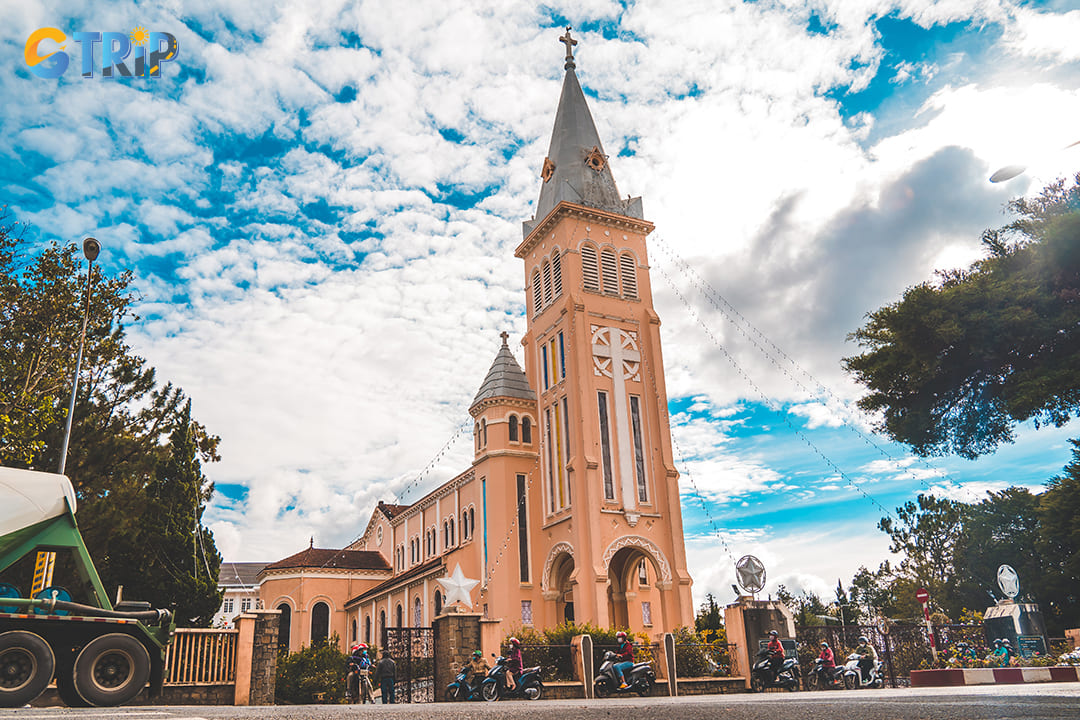
The best time to visit Dalat Cathedral is from November to April, which coincides with Dalat's dry season
How to get to Dalat Cathedral from the city center?
Located in the heart of Dalat, Dalat Cathedral is easily accessible from various points in the city. People have multiple transportation options, ranging from a short walk for those staying nearby to convenient taxi or motorbike rides.
Walking to Dalat Cathedral
For travelers staying near Xuan Huong Lake or Lam Vien Square, walking to the cathedral is a great option. The route is scenic, passing by Xuan Huong Lake, where you can enjoy the fresh air and charming landscapes before reaching the cathedral. The total walking distance from Dalat Market is approximately 1 kilometer, taking about 15 minutes.
Taking a taxi or ride-hailing service
Taxis are widely available in Dalat and provide a quick and comfortable way to reach Dalat Cathedral. Popular taxi companies like Mai Linh and Lado Taxi offer reliable services, and ride-hailing apps such as Grab are also available. A taxi ride from most central locations, including Dalat Old Train Station, typically takes around 5 - 10 minutes.
Renting a motorbike for flexibility
For people who prefer flexibility, renting a motorbike is an excellent choice. Many rental shops in the city center offer affordable daily rates, allowing tourists to explore not only the cathedral but also nearby attractions such as Dalat Crazy House. Parking is available near the cathedral, making it a convenient stop on a self-guided tour. After visiting the cathedral, many travelers continue exploring other notable landmarks nearby, such as Summer Palace of Bao Dai.
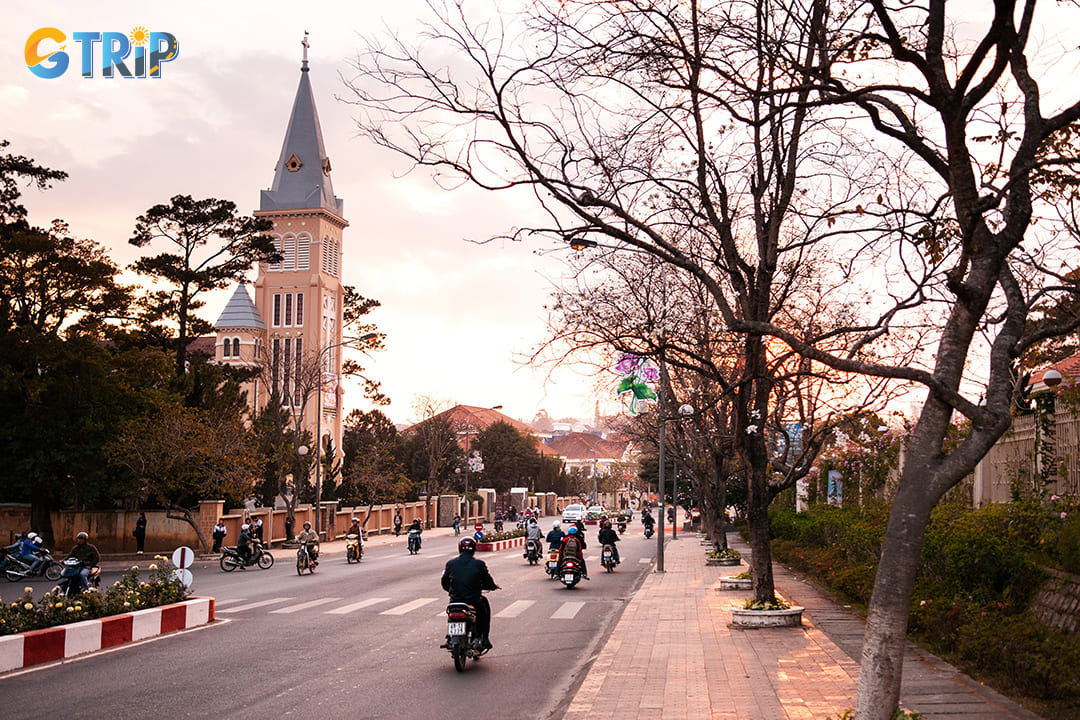
Located in the heart of Dalat, Dalat Cathedral is easily accessible from various points in the city
5 things to do when visiting Dalat Cathedral
Here are some of the activities that you can do when visiting this beautiful church.
1. Admire the French colonial architecture
Dalat Cathedral, also known as Con Ga Church, is a remarkable example of French colonial architecture in Dalat. Built during the early 20th century, its tall bell tower, pointed arches, and intricate details reflect the elegance of European design. Walking around the cathedral, you can observe the harmonious blend of Western architectural elements with local influences, creating a unique structure that stands out among religious sites in Dalat. The church’s facade, with its soft pastel tones and towering cross, makes it an iconic landmark that embodies the city’s colonial past.
2. Attend a mass and experience the local religious culture
For those interested in Catholic churches in Dalat, attending a mass at Dalat Cathedral provides an opportunity to experience the local religious customs. The serene atmosphere, combined with the soft echoes of prayers and hymns, allows you to witness the spiritual essence of the city. Services are conducted in Vietnamese, but the universal nature of the Catholic liturgy makes it easy for anyone to follow along. To fully appreciate this experience, check the Dalat Cathedral mass schedule in advance to align your visit with a service.
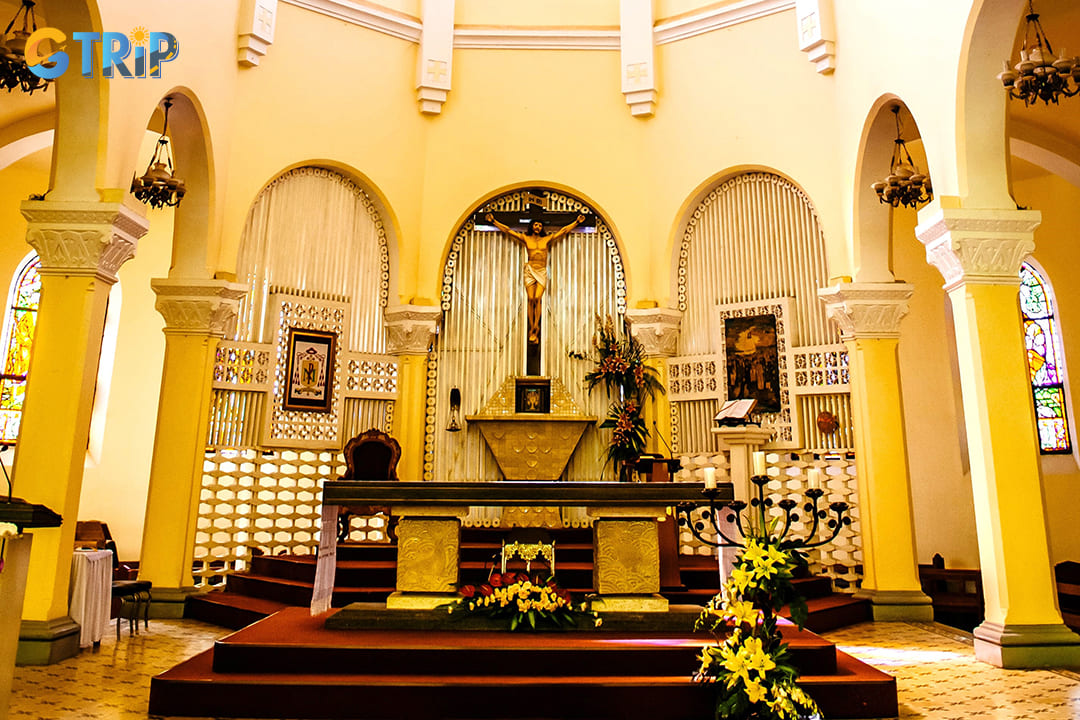
For those interested in Catholic churches in Dalat, attending a mass at Dalat Cathedral provides an opportunity to experience the local religious customs
3. Capture stunning photos of the stained glass windows
One of the cathedral’s most captivating features is its stained glass windows, which depict various biblical scenes in vibrant colors. These windows, imported from France, create a mesmerizing effect when sunlight filters through, casting a spectrum of hues onto the church’s interior. Early morning or late afternoon is the best time for photography, as the natural light enhances the vivid details of the glasswork. When capturing Dalat Cathedral interior photos, explore different angles to highlight the contrast between the Gothic-style arches and the warm glow of the sunlight.
4. Explore nearby religious sites like Domaine de Marie Church
A visit to Dalat Cathedral pairs well with exploring other religious sites in Dalat, such as Domaine de Marie Church. Located a short distance away, this pink-hued church showcases a blend of European and Vietnamese architectural elements. While Dalat Cathedral represents classical French Gothic style, Domaine de Marie’s design leans towards a more modern aesthetic with its curved roof and indigenous influences. After admiring the cathedral, a trip to Domaine de Marie offers a broader perspective on Dalat’s religious and architectural heritage.

A visit to Dalat Cathedral pairs well with exploring other religious sites in Dalat, such as Domaine de Marie Church
5. Enjoy the peaceful surroundings and scenic views of Dalat
Beyond its architectural beauty, Dalat Cathedral offers a tranquil setting that invites tourists to relax and appreciate the city’s scenic charm. The church is situated on an elevated area, providing a panoramic view of Dalat’s rolling hills and colonial-era buildings. A short walk from the cathedral leads to Lam Vien Square, a lively public space where travelers can soak in the fresh mountain air and capture stunning photos of Dalat’s urban landscape. For a more immersive experience, consider strolling toward Prenn Waterfalls, a natural retreat that contrasts the historical ambiance of the cathedral with lush greenery and cascading waters.
As you explore Dalat Cathedral and its surroundings, understanding the Dalat Cathedral mass times can help you plan your visit effectively. Up next, discover more about the church’s religious services, including daily mass schedules and special ceremonies for tourists.
Dalat Cathedral mass schedule and religious services
Dalat Cathedral mass times follow a structured schedule, accommodating both locals and tourists who wish to experience the sacred ambiance of this historic church. Regular mass services are conducted daily, with extended schedules on weekends and special occasions.
Daily and weekend mass schedule
- Weekdays (Monday to Saturday): Morning mass at 5:15 AM and evening mass at 5:15 PM.
- Sundays: The busiest day, featuring multiple services, typically at 5:30 AM, 7:00 AM, 8:30 AM, 4:00 PM, and 6:00 PM. The morning services attract large congregations, making it an ideal time for tourists to witness the religious devotion of the local community.
Special religious events and services
Beyond regular Catholic churches in Dalat services, the Dalat Cathedral hosts special religious celebrations, including Christmas Eve, Easter, and local feast days. These occasions are marked by vibrant ceremonies, choir performances, and beautifully decorated interiors. During these events, you can experience a unique blend of Vietnamese and French Catholic traditions.
Guidelines for attending mass
- Dress modestly: As it is a place of worship, you should wear appropriate attire, avoiding sleeveless shirts or shorts.
- Arrive early: Particularly on Sundays and during festive periods, arriving at least 15 minutes before mass ensures a good seating spot.
- Respect the ceremony: Tourists are welcome to attend but should observe silence, refrain from flash photography, and follow the congregation’s etiquette.
For those exploring the area after attending mass, the nearby Prenn Waterfalls offers a serene retreat, perfect for a peaceful nature experience. Another notable landmark is Robin Hill, where you can take a scenic cable car ride overlooking Dalat’s lush landscapes. Dalat Cathedral's role extends beyond religious services, it stands as a cultural and historical landmark reflecting the city's colonial past. Tourists intrigued by Dalat’s unique architecture will find another stunning example at The Cock Church – The Cathedral of Dalat City, which shares similar architectural influences.
For those interested in further exploration, the surroundings of Dalat Cathedral offer numerous attractions, from bustling markets to scenic lakes.
5 nearby attractions around Dalat Cathedral
There are many nearby attractions that you can visit after exploring Dalat Cathedral.
1. Dalat Flower Park (700m)
Located just a short walk from Dalat Cathedral, Dalat Flower Park is a vibrant showcase of the city’s floral beauty. Spanning over 7,000 square meters, this botanical paradise is home to a diverse collection of flowers that bloom year-round, including hydrangeas, orchids, roses, and cherry blossoms. Carefully landscaped gardens, scenic ponds, and decorative flower tunnels create a visually stunning environment, making it a favorite spot for photography enthusiasts. The park's design highlights Dalat’s reputation as the "City of flowers", offering a tranquil escape into nature amidst the city's cool climate.
One of the park’s most anticipated events is the Dalat Flower Festival, held every Tet holiday, where thousands of vibrant blooms are arranged in elaborate displays and artistic installations. During this time, the park becomes a colorful wonderland, attracting tourists from across Vietnam and beyond. Beyond its aesthetic appeal, Dalat Flower Park also serves as an educational space, with sections dedicated to rare plant species and horticultural research.
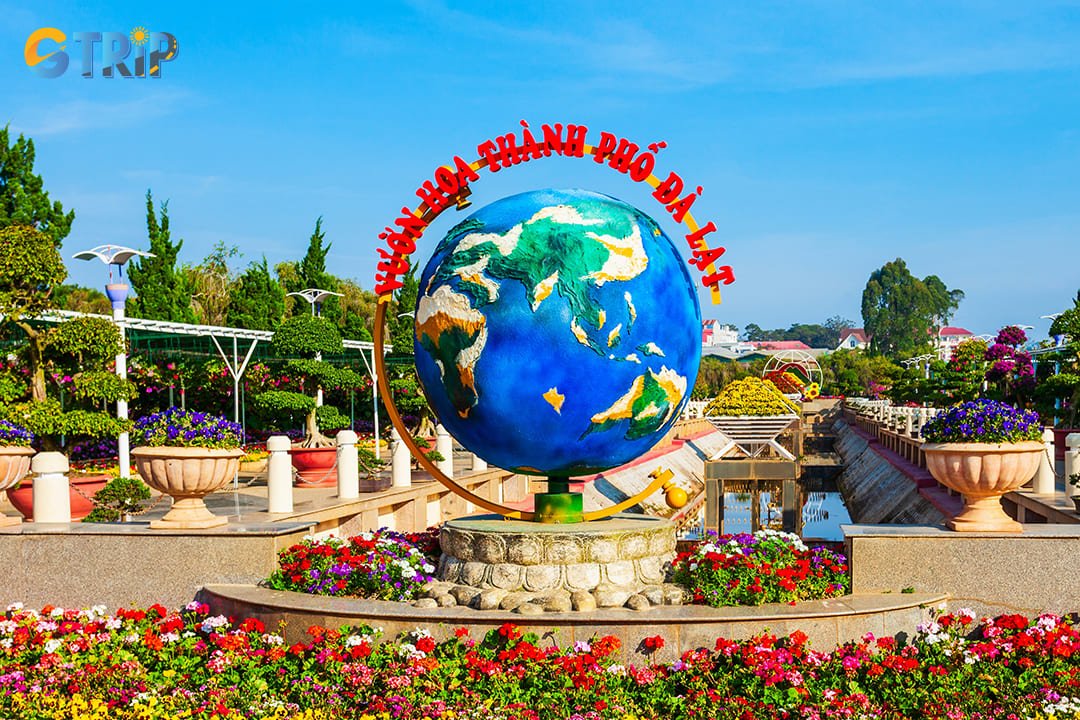
Dalat Flower Park is a vibrant showcase of the city’s floral beauty
2. Xuan Huong Lake (1km)
As the heart of Dalat, Xuan Huong Lake offers a serene retreat with its glassy waters reflecting the surrounding pine forests and colonial-era villas. Stretching 5 kilometers, the lake is an ideal spot for a leisurely walk, a scenic bike ride, or a peaceful boat ride on a swan-shaped pedal boat. In the early morning, the mist rolling over the lake creates a dreamlike atmosphere, making it a popular location for photographers and nature lovers. Along its shores, you’ll find charming cafés and teahouses, where you can enjoy a warm cup of Dalat coffee while soaking in the tranquil scenery.
Xuan Huong Lake is also a hub for outdoor activities, attracting both locals and tourists who come here for jogging, cycling, and even horseback riding. On special occasions, the lake transforms into a venue for festivals and fireworks displays, particularly during the Dalat Flower Festival. Xuan Huong Lake offers a refreshing escape from the hustle and bustle of city life.
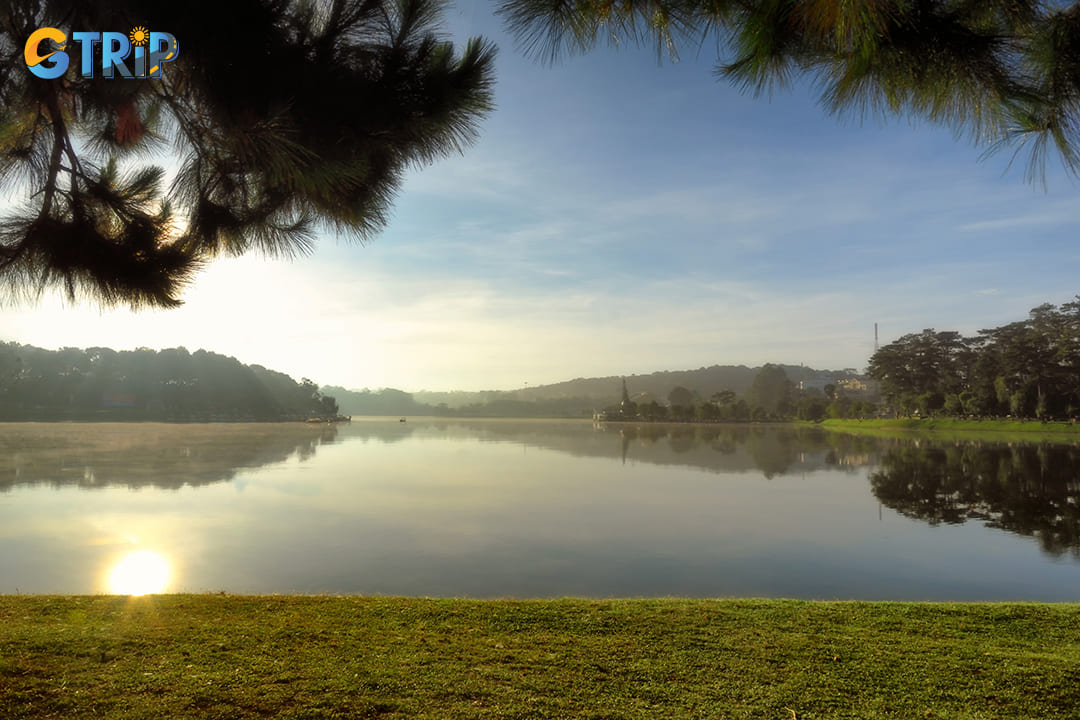
Xuan Huong Lake offers a serene retreat with its glassy waters reflecting the surrounding pine forests and colonial-era villas
3. Lam Vien Square (1km)
A blend of modern architecture and open public space, Lam Vien Square stands out as one of Dalat’s most iconic landmarks. The square is best known for its giant glass artichoke and sunflower-shaped buildings, which house a cafe and shopping area. These unique structures symbolize Dalat’s famous agricultural products, particularly artichokes, which are widely used in local herbal teas. The square’s expansive open space is a popular gathering point for locals and tourists, often hosting cultural events, street performances, and festivals.
As night falls, Lam Vien Square transforms into a lively hub, illuminated by colorful LED lights. Families, couples, and groups of friends gather here to enjoy Dalat’s cool evening air, take photos, or simply relax by the lakeside. The square is also a hotspot for street food lovers, with vendors selling banh trang nuong (Vietnamese pizza), fresh strawberry smoothies, and grilled skewers.
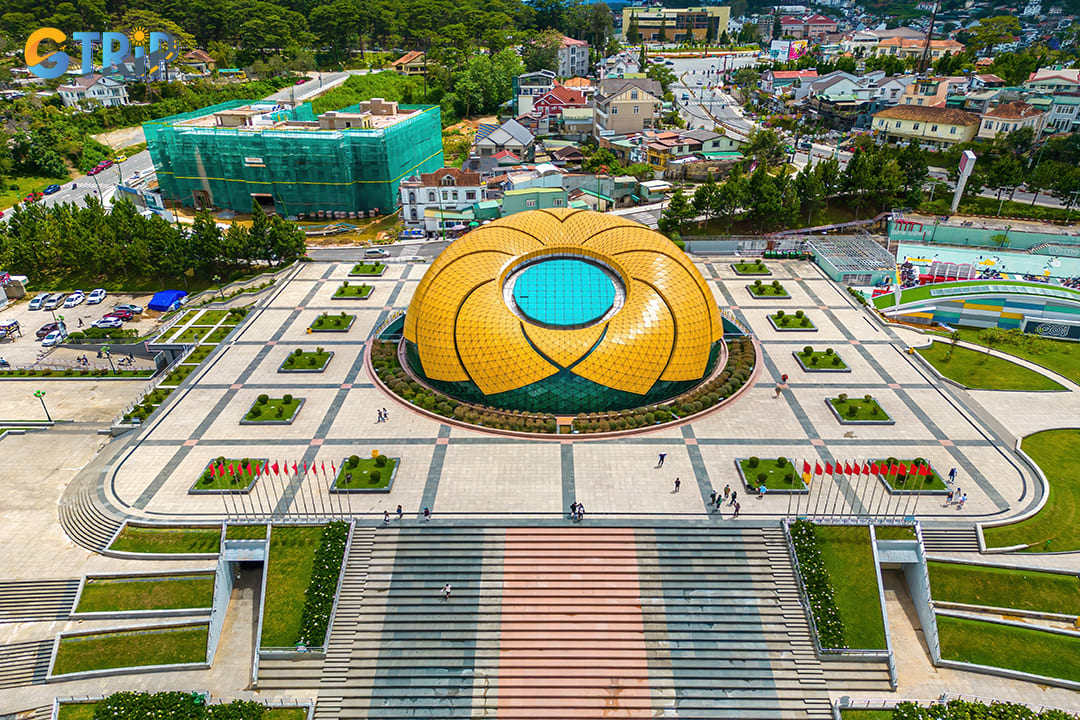
Lam Vien Square stands out as one of Dalat’s most iconic landmarks
4. Dalat Market (850m)
A trip to Dalat wouldn’t be complete without exploring Dalat Market, the city’s bustling commercial hub. Located in the city center, this multi-level marketplace is packed with vendors selling fresh produce, dried fruits, local delicacies, and handmade souvenirs. Among the most sought-after products are Dalat’s famous strawberries, avocados, artichoke tea, and locally grown coffee, which make for perfect gifts or personal treats. The market also has a section dedicated to wool clothing, where you can find affordable sweaters, scarves, and hats, perfect for Dalat’s chilly weather.
In the evening, the Dalat Night Market takes over the streets outside the main building, creating a vibrant street food scene. Stalls offer an array of grilled skewers, crispy rice paper pancakes (banh trang nuong), hot soy milk, and fresh fruit smoothies. The atmosphere here is lively and energetic, with street performers and crowds adding to the experience.
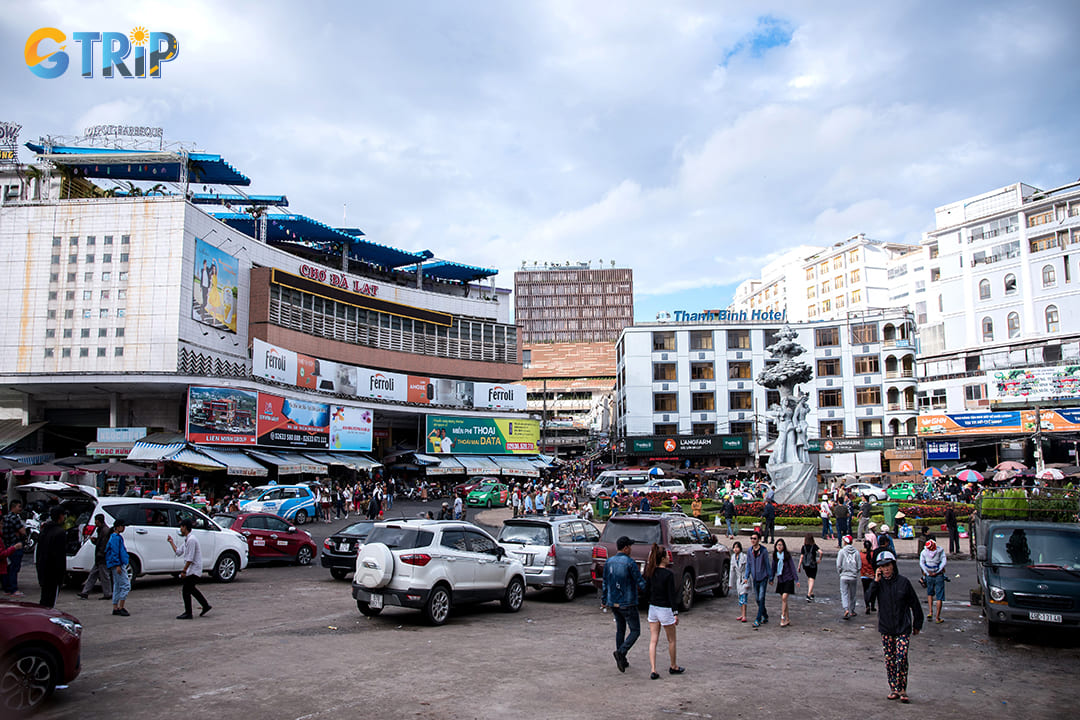
A trip to Dalat wouldn’t be complete without exploring Dalat Market, the city’s bustling commercial hub
5. Crazy House (850m)
For those seeking a truly unique experience, Crazy House is one of Dalat’s most surreal attractions. Designed by Vietnamese architect Dang Viet Nga, this architectural marvel defies conventional design with its tree-like structure, twisting staircases, narrow tunnels, and unconventional shapes. Each room is themed after different animals, such as tigers, eagles, and ants, blending elements of nature and fantasy. The house is often compared to Gaudí’s works in Barcelona, featuring organic, free-flowing forms that create a dreamlike atmosphere.
More than just a tourist attraction, Crazy House is also a functioning guesthouse, allowing you to stay overnight in one of its whimsical rooms. Each accommodation offers a one-of-a-kind experience, with interiors that feel like stepping into a fairytale or surrealist painting. The design reflects the architect’s vision of promoting harmony between humans and nature, making it both an artistic statement and an immersive architectural journey.
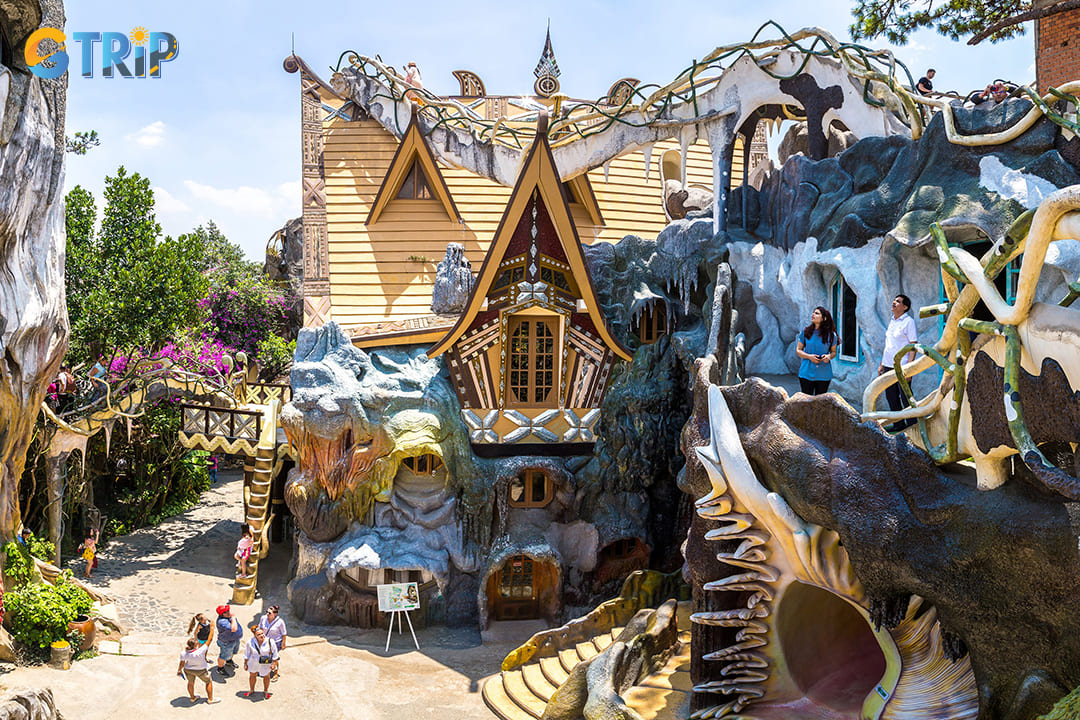
For those seeking a truly unique experience, Crazy House is one of Dalat’s most surreal attractions
Photography tips for Dalat Cathedral
Capturing the beauty of Dalat Cathedral's stained glass and its elegant French colonial architecture requires the right timing, angles, and lighting conditions. Here are some tips for you:
- Best timing: Shoot in the morning or late afternoon for soft golden light and vibrant stained glass reflections.
- Highlight architecture: Use low-angle shots to emphasize the bell tower, arches, and European-style design.
- Dynamic compositions: Experiment with unique angles, leading lines, and side perspectives to create depth.
- Use reflections & foregrounds: Capture reflections in puddles or glass surfaces, and frame shots with trees or flowers.
- Explore different angles: Include Dalat’s misty hills or surrounding landscapes for a more striking composition.
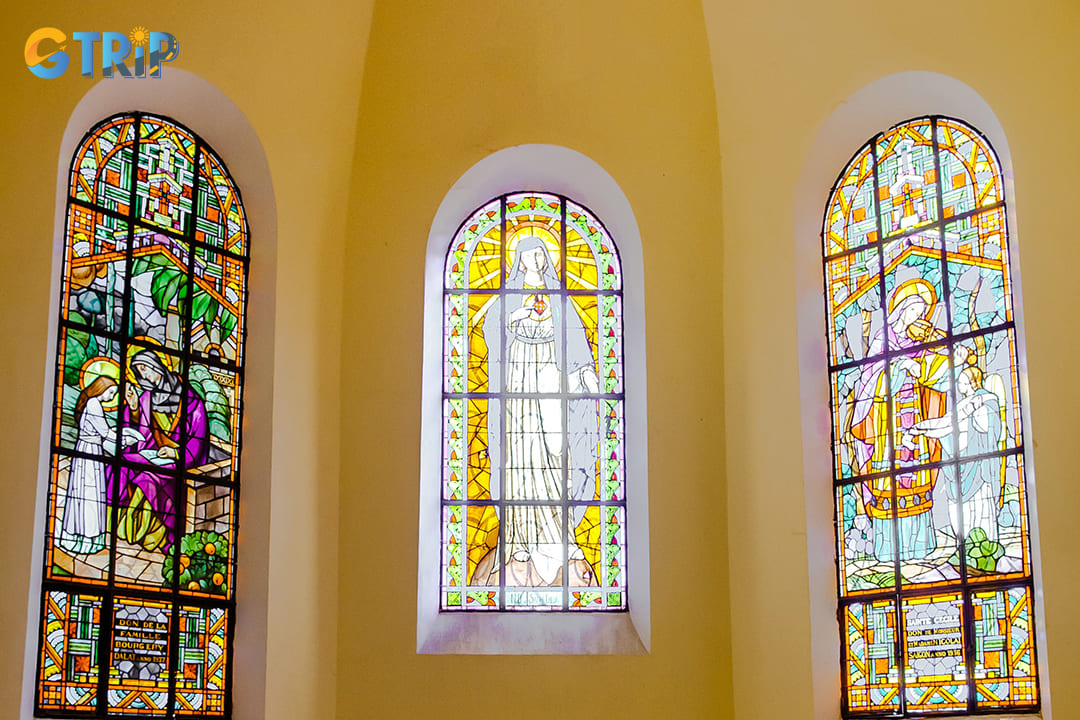
You should capture the beauty of Dalat Cathedral's stained glass and its elegant French colonial architecture
Tips for visiting Dalat Cathedral
Dalat Cathedral visitor guide is essential for those planning to explore this iconic religious site. To make the most of your visit, consider these practical tips to ensure a smooth and enjoyable experience.
1. Visit during non-peak hours
Dalat Cathedral can get quite crowded, especially on weekends and during religious holidays. To experience the serene atmosphere and appreciate the French colonial architecture, visit early in the morning or late in the afternoon. The golden hour lighting during these times also provides the best conditions for photography, highlighting the intricate details of the stained glass windows.
2. Dress modestly and respect the religious setting
As a place of worship, you should dress appropriately when entering the cathedral. Avoid wearing shorts, sleeveless tops, or overly casual attire. Respecting local customs will not only enhance your experience but also allow you to participate in religious services if you choose.
3. Check the mass schedule in advance
For those interested in attending a religious service, checking the Dalat Cathedral mass times beforehand is crucial. Masses are conducted primarily in Vietnamese, but the spiritual experience and ambiance can be appreciated by all tourists. Arrive a few minutes early to find a seat and observe the local traditions.
4. Explore nearby attractions
After visiting the cathedral, take the opportunity to explore some of Dalat’s must-see landmarks. Just a short distance away, Linh Phuoc Pagoda offers a stunning mosaic design crafted from broken ceramic tiles, making it an architectural marvel. If you prefer nature, Puppy Farm is an excellent choice for animal lovers, you can interact with friendly dogs and enjoy the colorful flower gardens.
5. Be mindful of photography etiquette
While taking photos inside the cathedral is allowed, be respectful of worshippers and avoid using flash during services. The best spots for capturing the grandeur of Dalat Cathedral’s interior are near the altar and along the side aisles, where the stained glass windows create a mesmerizing light display.
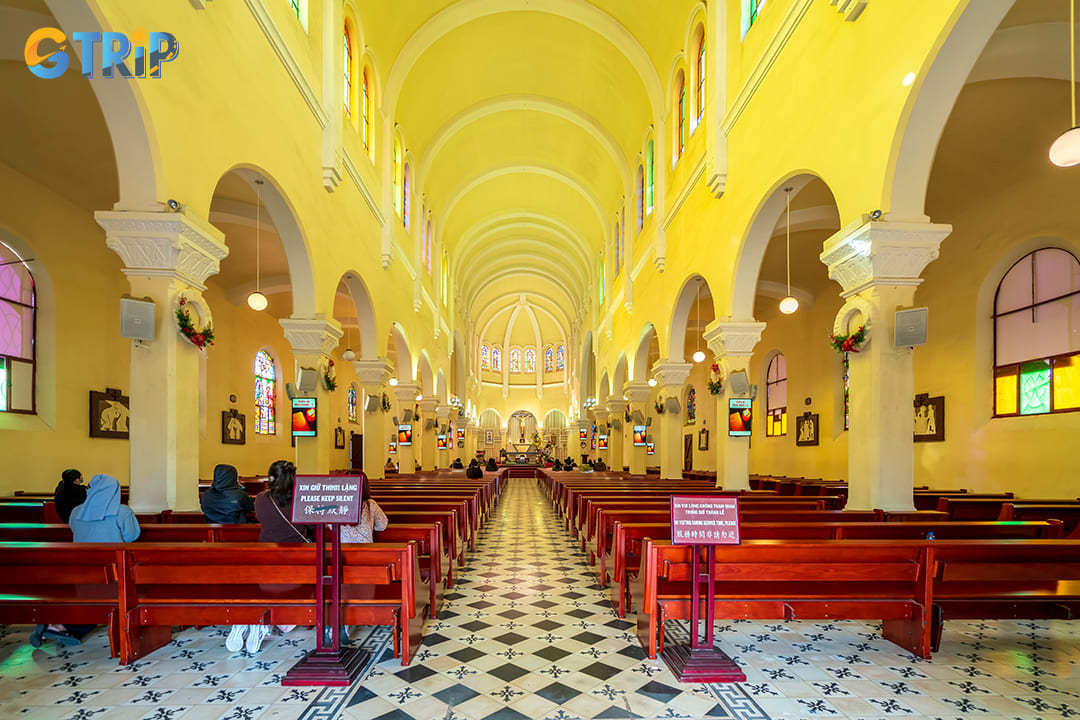
As a place of worship, you should dress appropriately when entering the cathedral
Visiting Dalat Cathedral is a rewarding experience, offering a blend of history, architecture, and spirituality. As you complete your visit, consider exploring other scenic spots nearby, such as Tuyen Lam Lake, which provides a tranquil escape amidst nature. To make the most of your trip, plan your visit during the ideal season, respect local customs, and take time to enjoy nearby attractions. If you’re looking to explore more of Dalat’s iconic landmarks, cultural sites, and scenic landscapes, check out our curated Da Lat tours for a complete travel experience. GTrip - Vietnam Travel Agency is here to help you uncover the best of Dalat with expert guidance and tailored itineraries.

